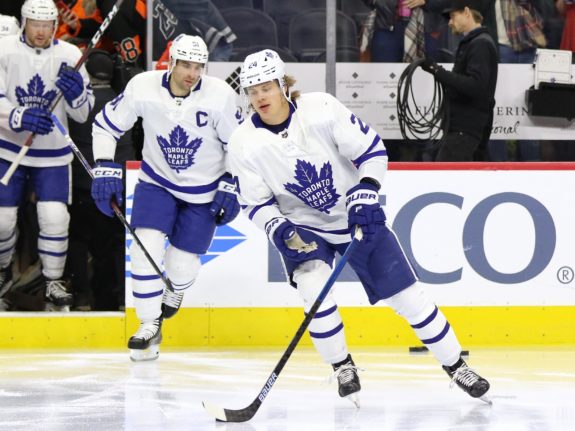Kasperi Kapanen appeared shirtless during an introductory press conference after the Pittsburgh Penguins acquired him on Aug. 25.
The 24-year-old forward had just been traded from the Toronto Maple Leafs, with whom he had spent the previous five seasons. Kapanen, who was drafted by Pittsburgh in 2014, had gone to Toronto as part of a trade that sent forward Phil Kessel to the Penguins on July 1, 2015.
Funny enough, Kapanen’s intro back to Pittsburgh showed some of the same personality Kessel possessed. Not that Kessel would show up to a video call without a shirt, but that he had a unique demeanor, one unlike what’s usually expected from the Penguins.
Kessel’s quirks made him a favorite in Pittsburgh, as Kapanen’s could. But Kessel also won the Stanley Cup twice (2016 and 2017) and had 303 points (110 goals, 193 assists) in four seasons with the Penguins.
Starting this season, Kapanen could at least come close to that production.
Taking Another Step
Building on what he’s already done could be more than enough for Kapanen. He had a solid first season with the Penguins, one better than probably most predicted. And if he and second-line center Evgeni Malkin would have been healthy throughout, this discussion might be moot, as he already might have had his breakout season.

In 40 games, Kapanen had 30 points (11 goals, 19 assists) (from ‘Penguins A to Z: Kasperi Kapanen found what he’s been looking for,’ Trib Live, 06/29/2021). Across a full 82-game schedule, that would be on pace for 62 points (23 goals, 39 assists). His previous career-high in each category came in 2019 when he had 44 points (20 goals, 24 assists) in 78 games.
Kapanen was able to pull off last season despite lacking any sort of consistency. His campaign was thrown into turmoil right from the beginning, as he missed training camp and the first three games because of immigration issues and a mandatory quarantine.
After getting an assist in each of his first two games with Pittsburgh, Kapanen scored his first goal in a 3-2 overtime loss to the Boston Bruins on Jan. 26. He had seven points (two goals, five assists) in his first 13 games.
Kapanen got it going starting Feb. 23, when he had a goal and an assist against the Washington Capitals. From that date forward, he had 23 points (nine goals, 14 assists) in 27 games. With some stability, more should be expected next season.
Chemistry with Malkin
When acquired, Kapanen was thought to be the right wing on Sidney Crosby’s line. But his delayed start to the season changed things.
Evan Rodrigues was used at first-line right wing, next to Crosby at center, and Jake Guentzel at left wing, instead. Ultimately, that role would go to Bryan Rust, who had a career year. Kapanen did get a look on that line but didn’t seem to fit as well as expected.
So, he was used next to Malkin. That was for the best.

Malkin, who struggled early this past season, found his game in early March. The relationship with Kapanen was key to Malkin’s eight-game point streak from March 2-15, where he had 12 points (four goals, eight assists). Kapanen had nine points (four goals, five assists) in those eight games.
But a knee injury to Malkin changed things on March 16. He missed most of the remaining schedule, playing just four games in the regular season and missing the first two games of a Stanley Cup First Round series against the New York Islanders.
Kapanen sustained a lower-body injury on March 24, keeping him out 13 games. To his credit, Kapanen had a goal and an assist in his return on April 22 and had eight points (four goals, four assists) in his final 10 games this season.
But if he and Malkin remained healthy, Kapanen’s inaugural season in Pittsburgh could have been all the more impressive.
Malkin required offseason knee surgery, which will hold him out at least through training camp. How quickly he returns and how he performs upon his return could determine how effective Kapanen can be next season.
If Malkin comes back healthy and motivated, Kapanen could have a season similar to some Kessel enjoyed in Pittsburgh. Kapanen probably wouldn’t reach his heights of 92 points (34 goals, 58 assists) in 2017-18, but Kessel averaged 28 goals per season with the Penguins, and that could be very doable.
Channeling Emotion
Two days after the Penguins were eliminated by the Islanders in the first round on May 26, several players were made available. They were all obviously frustrated, but none were as emotional as Kapanen.
Showing up to his virtual scrum in a purple bucket hat and a Nike shirt with a large graphic of a wolf howling in front of a moon, Kapanen was asked what the previous four or five months had meant to him.
“It wasn’t the start that I wanted, for sure,” Kapanen said, as his voice seemed to crack. “But just a great group of guys. Kind of like welcomed me in. Made me feel at home, in a way, for sure. I’m grateful for that and the way that it ended was obviously short.
Latest Penguins Content:
- Penguins’ Kyle Dubas Already on the Hot Seat This Season
- 4 Things Patrick Roy Can Learn From Jon Cooper & Mike Sullivan
- Pittsburgh Penguins’ 10 Best Defensemen in Team History
- Hockey History – the NHL “Second Six”
- Penguins’ Projected 2024-25 Opening Night Lineup
“It sucks right now, but I’m very grateful for the way the guys kind of made me feel at home and made me feel a part of this team. I appreciate that. So, I don’t know. That’s my best answer.”
It was clear Kapanen cared. He had a visceral response to losing. He had a visceral response to feeling like part of this group.
That mattered to Kapanen, and therefore, he’d likely be motivated to progress further next season. And if he does, again next to a healthy Malkin, Pittsburgh could have one of the better top-six forward groups in the NHL.